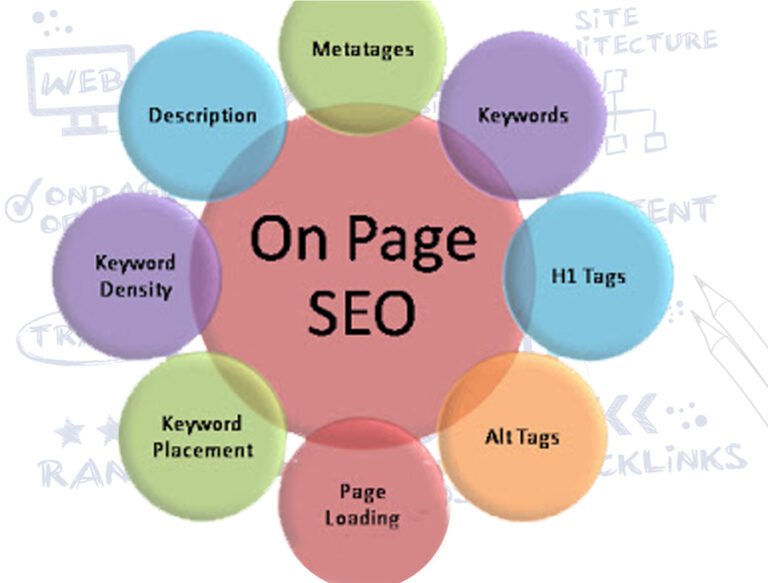How to do on-page seo for website and blogs

Introduction:
On-page SEO (Search Engine Optimization) is the process of optimizing individual pages on a website or blog to rank higher in search engine results and attract more relevant traffic. It involves various techniques that improve the content, structure, and technical aspects of a page. Here’s a step-by-step guide on how to perform on-page SEO:
1. Keyword Research for on-page seo
Identify Primary Keywords: Find relevant keywords using tools like Google Keyword Planner, SEMrush, or Ahrefs.
Long-Tail Keywords: Target long-tail keywords (phrases with 3-4 words) as they often have less competition but higher intent.
Focus on Search Intent: Choose keywords that align with what users are searching for and their intentions (informational, transactional, etc.).
2. Optimize Title Tags
Primary Keyword Placement: Place your primary keyword near the beginning of the title.
Keep It Concise: Titles should be under 60 characters to avoid truncation in search results.
Engaging and Relevant: Make it compelling to attract clicks while staying relevant to the content in one-page seo.
3. Create SEO-Friendly URLs
Short and Descriptive: Use short URLs that describe the page content.
Include Keywords: Incorporate your target keywords naturally.
Avoid Special Characters: Keep URLs clean, avoiding special characters or excessive numbers.
4. Header Tags (H1, H2, H3, etc.)
H1 Tag: Use a single H1 tag that includes your primary keyword. It’s often the title of the page or post.
Subheadings: Use H2 and H3 tags to structure content and include secondary keywords.
Readable Structure: Break content into sections for easy readability and better user experience.
5. Content Optimization
Quality and Depth: Write in-depth, valuable content that thoroughly covers the topic. Aim for at least 1000-2000 words if the topic warrants it
Keyword Placement: Include your main keyword in the first 100 words and naturally throughout the content.
Synonyms and LSI Keywords: Use related keywords and phrases (Latent Semantic Indexing) to give context and avoid keyword stuffing.
Answer Search Queries: Provide clear, concise answers to common questions users have about your topic in on-page seo.
6. Meta Descriptions for on-page seo
Include Keywords: Write a descriptive meta description that includes your primary keyword.
Persuasive and Engaging: Keep it around 155-160 characters, and make it enticing to encourage users to click through.
Unique for Each Page: Avoid duplicating meta descriptions across multiple pages.
7. Internal Linking
Strategically Link to Other Pages: Link to other relevant pages on your site to improve site structure and user navigation.
Anchor Text: Use keyword-rich anchor text, but ensure it feels natural and relevant.
Avoid Over-Linking: Don’t add too many internal links, as it can dilute the effectiveness.
8. Image Optimization
Descriptive File Names: Name your image files with descriptive, keyword-rich names.
Alt Text: Add alt text to every image using keywords where appropriate. This helps with accessibility and image SEO.
Optimize Image Size: Compress images to reduce load time without losing quality.
9. Page Load Speed
Fast Loading Pages: Use tools like Google PageSpeed Insights to analyze and improve page speed.
Compress Media Files: Optimize images, videos, and other media to reduce page load time.
Enable Browser Caching: Leverage browser caching to load pages faster for returning visitors.
10. Mobile Friendliness
Responsive Design: Ensure your website is mobile-friendly and adapts to different screen sizes.
Mobile Usability: Test your site’s usability on mobile devices using tools like Google’s Mobile-Friendly Test.
11. Use Schema Markup
Structured Data: Add schema markup (structured data) to help search engines understand your content and display rich results (like reviews, ratings, etc.).
Common Types: Use common schemas like FAQs, breadcrumbs, product pages, articles, and more, depending on your content type.
12. User Engagement Signals
Optimize for Readability: Use short paragraphs, bullet points, and visuals to make content easy to scan.
Engaging Content: Incorporate multimedia elements (videos, infographics) to keep users engaged longer, reducing bounce rates.
Call to Action (CTA): Include strong CTAs to guide users to take action (subscribe, buy, etc.).
13. Social Sharing
Share Buttons: Add social media sharing buttons to your blog posts to encourage sharing.
Social Media Meta Tags: Implement Open Graph (for Facebook) and Twitter Card tags to control how your content looks when shared.
14. Technical SEO
Canonical Tags: Use canonical tags to avoid duplicate content issues.
XML Sitemap: Ensure you have a sitemap submitted to search engines like Google and Bing.
Robots.txt File: Manage crawling of your site with a properly configured robots.txt file.
By following these on-page SEO practices, you’ll help your website or blog rank higher in search engine results, increase visibility, and attract more organic traffic.
